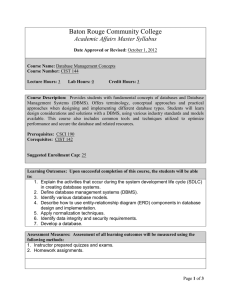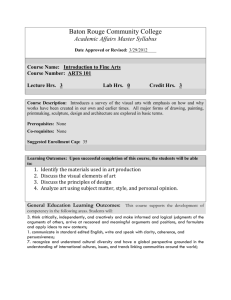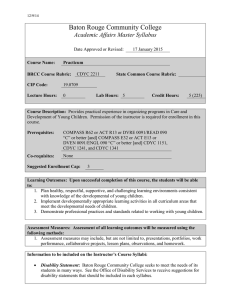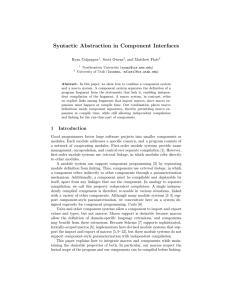Baton Rouge Community College Academic Affairs Master Syllabus
advertisement
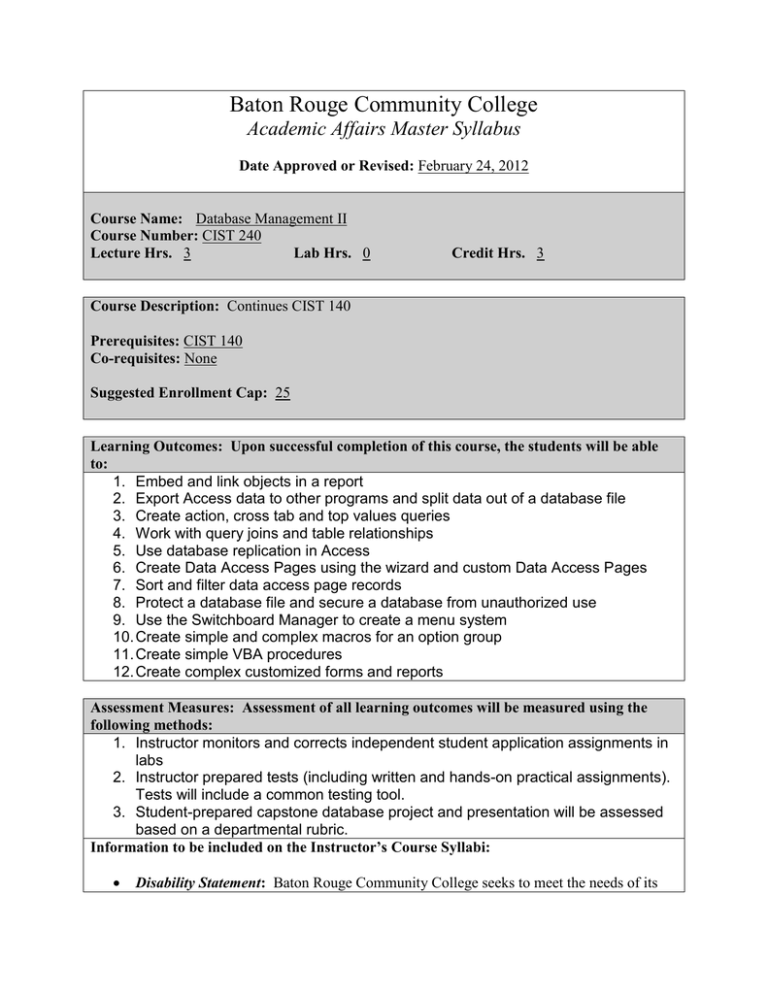
Baton Rouge Community College Academic Affairs Master Syllabus Date Approved or Revised: February 24, 2012 Course Name: Database Management II Course Number: CIST 240 Lecture Hrs. 3 Lab Hrs. 0 Credit Hrs. 3 Course Description: Continues CIST 140 Prerequisites: CIST 140 Co-requisites: None Suggested Enrollment Cap: 25 Learning Outcomes: Upon successful completion of this course, the students will be able to: 1. Embed and link objects in a report 2. Export Access data to other programs and split data out of a database file 3. Create action, cross tab and top values queries 4. Work with query joins and table relationships 5. Use database replication in Access 6. Create Data Access Pages using the wizard and custom Data Access Pages 7. Sort and filter data access page records 8. Protect a database file and secure a database from unauthorized use 9. Use the Switchboard Manager to create a menu system 10. Create simple and complex macros for an option group 11. Create simple VBA procedures 12. Create complex customized forms and reports Assessment Measures: Assessment of all learning outcomes will be measured using the following methods: 1. Instructor monitors and corrects independent student application assignments in labs 2. Instructor prepared tests (including written and hands-on practical assignments). Tests will include a common testing tool. 3. Student-prepared capstone database project and presentation will be assessed based on a departmental rubric. Information to be included on the Instructor’s Course Syllabi: Disability Statement: Baton Rouge Community College seeks to meet the needs of its students in many ways. See the Office of Disability Services to receive suggestions for disability statements that should be included in each syllabus. Grading: The College grading policy should be included in the course syllabus. Any special practices should also go here. This should include the instructor’s and/or the department’s policy for make-up work. For example in a speech course, “Speeches not given on due date will receive no grade higher than a sixty” or “Make-up work will not be accepted after the last day of class.” Attendance Policy: Include the overall attendance policy of the college. Instructors may want to add additional information in individual syllabi to meet the needs of their courses. General Policies: Instructors’ policy on the use of things such as beepers and cell phones and/or hand held programmable calculators should be covered in this section. Cheating and Plagiarism: This must be included in all syllabi and should include the penalties for incidents in a given class. Students should have a clear idea of what constitutes cheating in a given course. Safety Concerns: In some programs this may be a major issue. For example, “No student will be allowed in the safety lab without safety glasses.” General statements such as, “Items that may be harmful to one’s self or others should not be brought to class.” Library/ Learning Resources: Since the development of the total person is part of our mission, assignments in the library and/or the Learning Resources Center should be included to assist students in enhancing skills and in using resources. Students should be encouraged to use the library for reading enjoyment as part of lifelong learning. Expanded Course Outline: I. Working with HTML Documents, Data Access Pages, and Hyperlink Fields A. Export an Access table to an HTML document B. View an HTML document using a browser C. Use a Wizard to create a data access page for an Access table D. Update a data access page using a Web browser E. Sort and filter data access page records F. Create a custom data access page G. Import an HTML document as an Access table H. Add hyperlink fields to an Access table I. Create hyperlinks to Office documents and Web pages II. Using Query Wizards, Action Queries, and Briefcase Replication A. Use Query Wizards to create a crosstab query, a find duplicates query, and a find unmatched query B. Create a top values query C. Create action queries D. Define many-to-many relationships between tables E. View and create indexes for tables F. Join a table using a self-join G. View SQL query statements H. Use replication to create a Design Master and replica of a database I. Synchronize the Design Master and replica databases III. Automating Tasks with Macros A. Design a switchboard and dialog box for a graphical user interface B. Run and add actions to macros C. Single step a macro D. Create a macro E. Add a macro to a macro group F. Add a command button to a form G. Attach a macro to a command button H. Define data validation criteria I. Create a dialog box J. Add a list box to a form K. Use an SQL statement to fill a list box L. Create a macro group M. Use the Switchboard Manager to create a switchboard IV. Using and writing Visual Basic for Applications Code A. Learn about Function procedures, Sub procedures, and modules B. Review and modify an existing Sub procedure in an event procedure C. Create Function procedures in a standard module D. Create event procedures E. Compile and test Function procedures, Sub procedures, and event procedures F. Hide text and change display colors G. Encrypt and decrypt a database H. Set and unset a database password I. Analyze a database J. Split a database K. Set database startup options

